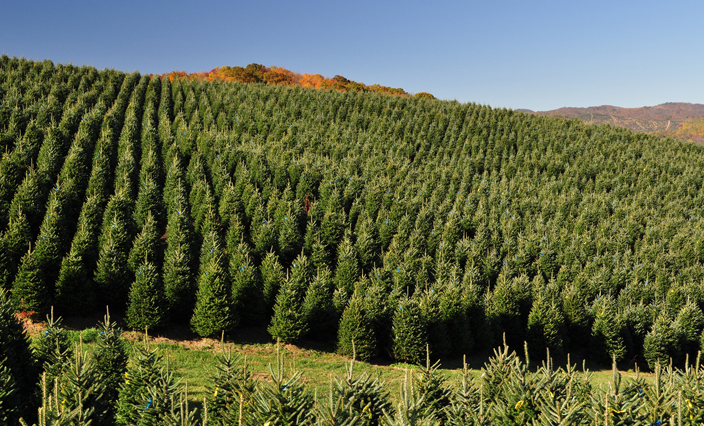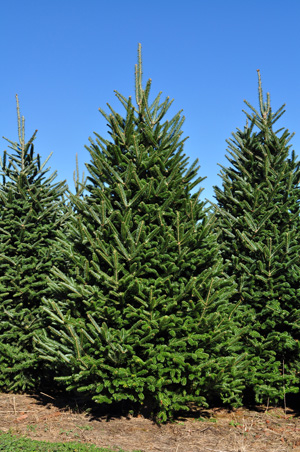
Fraser Fir Christmas Trees
Have you ever wondered where all the Christmas trees that show up on the lots around Thanksgiving come from? These trees are grown on plantations and shipped around the country to retail lots. It takes many years of hard work to produce a tree that is just right to become a Christmas tree.
Christmas trees begin their life in a nursery. Here, seeds are taken from cones of mature trees, planted and covered with straw. They are also covered with a shade cloth to prevent them from being damaged by frost or sun. After three years, the Fraser Fir trees, or seedlings, are ready to be moved to the line-out beds for further growth.
Line-out beds allow the seedlings to grow without competition from larger trees. With all the trees being relatively the same size, they have an equal opportunity for sunlight and water. The seedlings will stay in the line-out bed for two years or until they are strong enough to be transplanted into the field.
During the seven to eight years the trees remain in the field, we will spend time and effort in shaping them. After the trees reach a height of three feet, they are sheared for the first time.During the shearing process, the top of the tree, or leader, is cut back. By slowing the upward growth process, the tree will branch out more quickly. As the tree begins to branch out, the grower will trim the branches to shape the tree and give it a fuller appearance.
Shearing the tree is not the only management practice that the grower will engage in. Integrated Pest Management, a system of pest control methods that uses appropriate cultural practices and pesticide selection to reduce pests, is another management technique that we use. Growers also follow sound soil conservations practices, protecting soils from erosion and being careful not to deplete its nutrients.
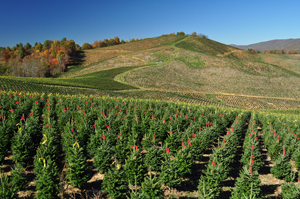
At harvest time, we identify finished trees by placing a ribbon on them. The ribbons are color coded with each height being assigned a different color. Often a whole field is not ready for sale in any one year. It often takes two to four years before a field is cleared and ready for new trees to be planted.
The tagged trees are cut and then bundled during a process called baling. During the baling process, the trees are placed in a machine that ties them in twine so that they are easier to ship. After being baled, the trees are taken to the loading yard where they are placed on trucks and shipped to retail lots all across the country.
Producing the best tree for your family that nature and nurture can provide takes much time and effort. It can take anywhere from twelve to fifteen years for a tree to be ready to harvest. Yet, Christmas tree growers agree that this long hard job is worth it when their trees become the decorative centerpiece of your home during the holiday season.
Growing and Harvesting Trees Help the Environment
Did you ever think that by using a live Christmas tree in your house that you were actually helping the environment? Real trees help the environment from the time they are planted until after the holiday season when they can be recycled.
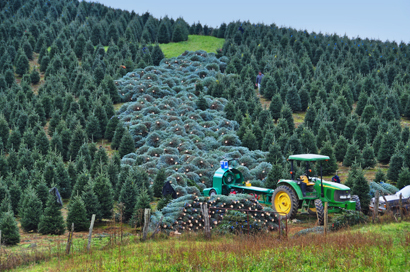
While they are growing, Christmas trees support life by absorbing carbon dioxide and other gases while giving off fresh oxygen. Every acre of Christmas trees planted gives off enough oxygen to meet the needs of 18 people. Today in America there are enough Christmas trees planted that 18 million people a day are supplied with oxygen. Also, the farms that grow Christmas trees stabilize soil, protect water supplies, and provide a refuge for wildlife while creating a nice scenic view. Often, Christmas trees are grown on soil that will not support any other crops. And when one Christmas tree is cut down, one or two are replanted in its place.
Artificial trees are made from oil-based products that use up our natural resources. They are also not recyclable and will remain in land-fills for centuries after disposal.
Real Christmas trees, on the other hand, are recyclable. The branches and trunk are biodegradable and can be made into mulch for the garden. A Christmas tree placed in the back yard will make a nice bird feeder and the birds can also use the trees branches for shelter during the winter winds. Large quantities of trees make effective barriers on beaches to prevent soil erosion. Sunk into ponds, the trees will also make an excellent refuge and feeding area for fish.
The Unique Fraser Fir
NC Tree Growers produce over 50 million Fraser Firs each year. The Fraser Fir was named for John Fraser, a Scottish botanist who explored the southern Appalachian Mountains of North Carolina in the late 1700s. It is a pyramid-shaped tree that reaches a maximum height of 80 feet and a trunk diameter of 1-1/2 feet.
The Fraser Fir grows naturally only in the southern Appalachians, above 3,000 feet. The cool temperatures and large amount of rainfall in the North Carolina High Country are what causes the Fraser Fir to keep its needles throughout the Christmas season.
Over 50 million Fraser Firs are grown in North Carolina on 25,000 acres for use as Christmas trees, and the Fraser Fir represents over 90% of all the trees grown in North Carolina as Christmas trees.
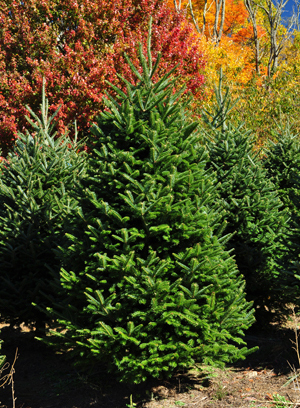
The First Christmas Trees
Christmas Trees haven't always been a Christmas tradition. No one really knows who put up the first Christmas tree, but some historians believe that even the Egyptians and Romans used some form of an evergreen to decorate their homes in late December.
It is generally agreed that the first use of a tree as part of the Christian Christmas celebration was started over 400 years ago by the Germans.
The Christmas tree was brought to America by the Hessian mercenaries that were paid to fight for the British during the Revolutionary War. In 1804, soldiers stationed at a fort near Chicago hauled trees to their barracks during Christmas.
In 1842, a German named Charles Minnegerode introduced the custom of decorated Christmas trees in Williamsburg, Virginia homes. His tree was described as being "splendidly decorated" with strings of popcorn, nuts, and lighted candles.
By 1900, one in five American families decorated trees during Christmas and by 1930, the tree had become a nearly universal part of the American Christmas.
More Information
If you need information about any of our services, please feel free to use our contact form, send us an e-mail to andy@powerstreefarm.com, or give us a call at 336-384-8828.
